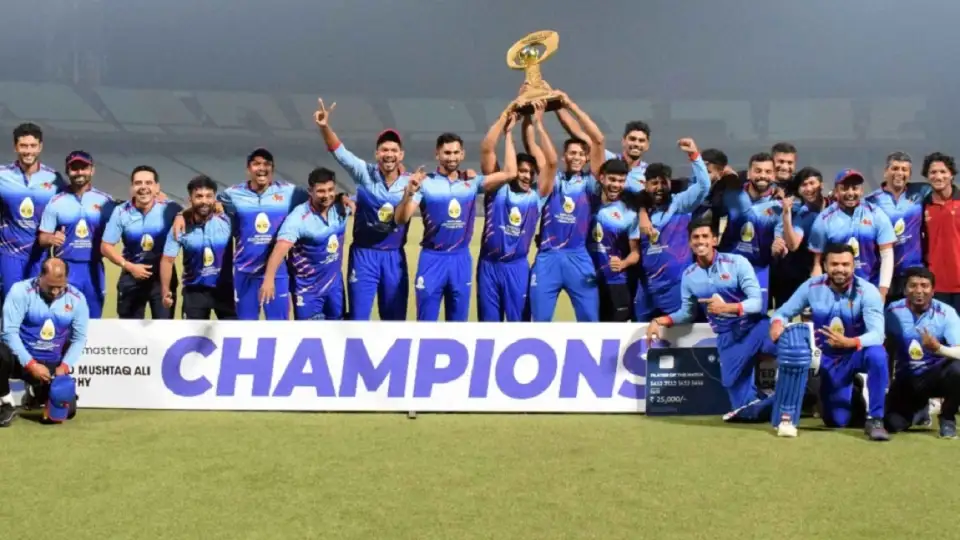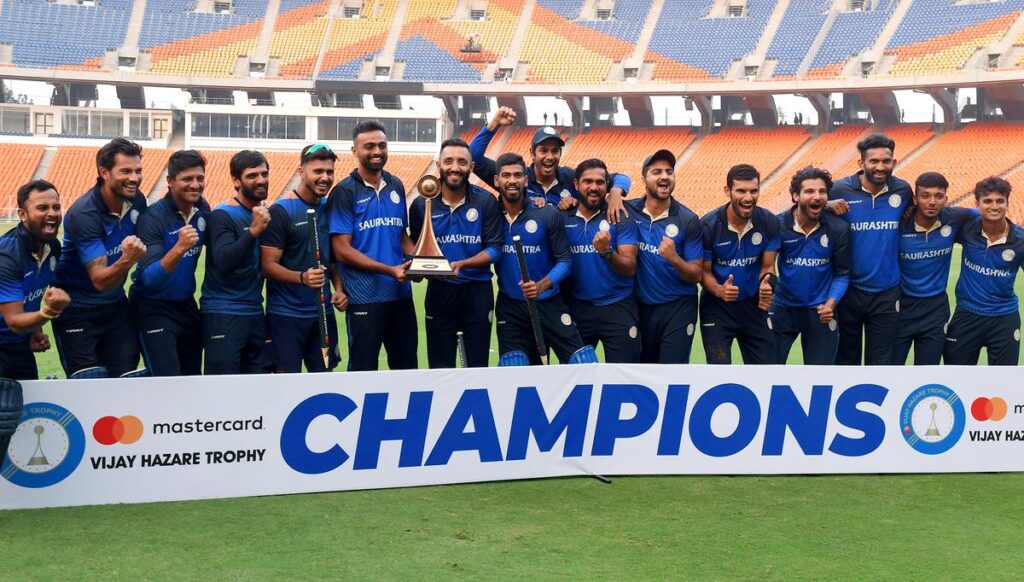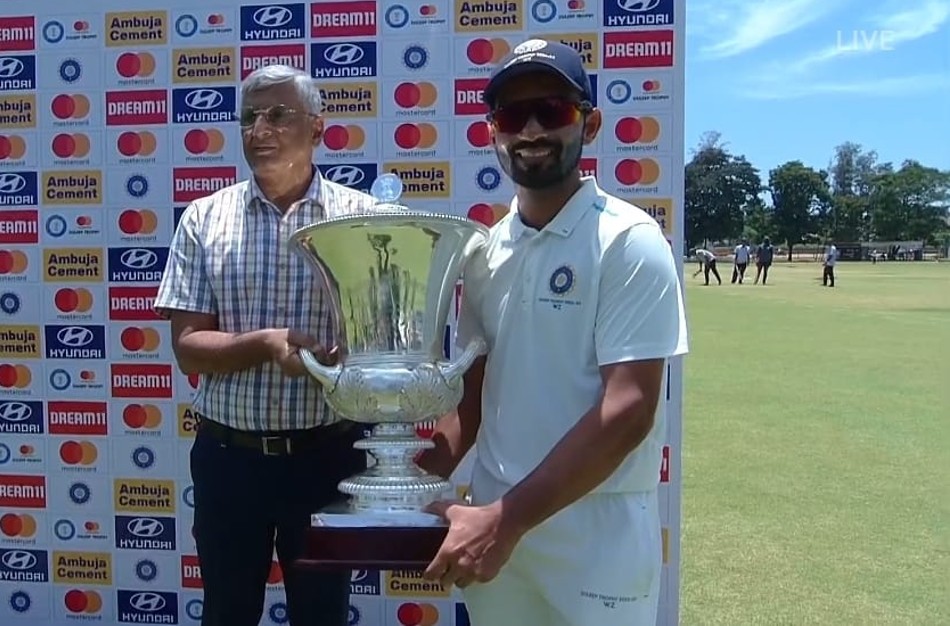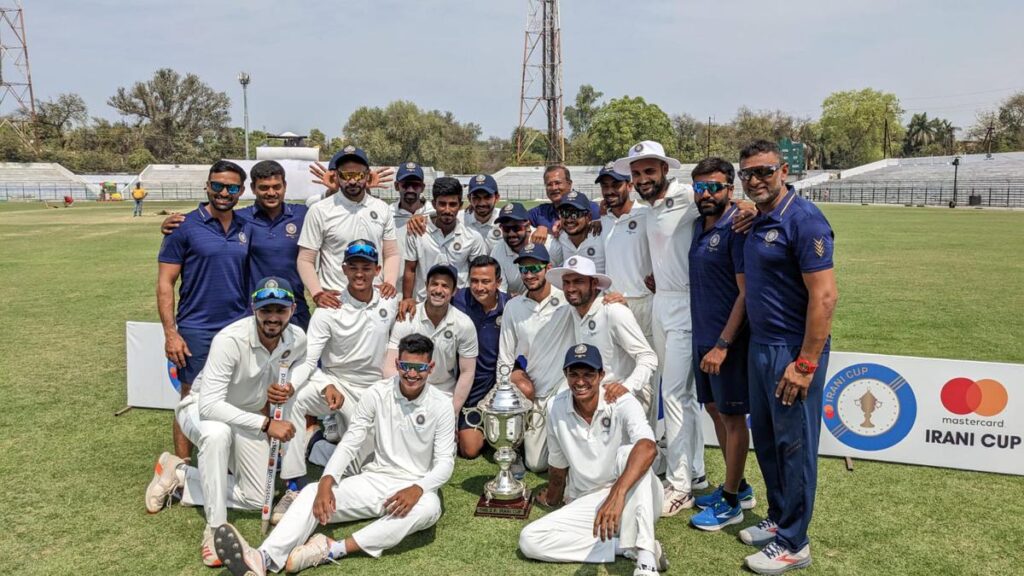Introduction to Domestic Cricket
A huge reason behind India’s success on the global stage is its strong and ever-growing domestic cricketing circuit. Right from a young age, cricketers play domestic competitions which builds their overall game and helps nurture their talent. Domestic Cricket and Regional Cricket are truly the backbone of the country’s cricketing ecosystem. It provides a platform for young cricketers to perform and progress throughout their cricketing journey.
Apart from fostering regional rivalries and the spirit of the game from a young age, the experience one gets when playing in cricket tournaments is extremely vital. Playing on Indian pitches across the country makes one evolve as a player in all aspects of the game. The anchor of these domestic cricket tournaments in India is without a doubt, the Ranji Trophy. There are other important tournaments as well, which include the Syed Mushtaq Ali Trophy, the Vijay Hazare Trophy, etc.
| Domestic cricket tournaments in India | Format | First edition | Successful team(s) |
| Ranji Trophy | First-class | 1934 | Mumbai |
| Duleep Trophy | First-class | 1961-62 | North and West zones |
| Irani Cup | First-class | 1959-60 | Rest of India |
| Deodhar Trophy | List A | 1973-74 | North Zone |
| Vijay Hazare Trophy | List A | 2002-03 | Tamil Nadu |
| Syed Mushtaq Ali Trophy | T20 | 2008-09 | Tamil Nadu, Karnataka, Baroda, Gujarat |
| Indian Premier League | T20 | 2008 | Mumbai Indians, Chennai Super Kings |
BCCI organizes all kinds of tournaments ranging from all three formats to nurture the young talent in India so that when the time comes, they can shine for the National Side. So let’s take a closer look at all these major cricket tournaments in India.
Ranji Trophy

History
It was all the way back in 1934 when the Board of Control for Cricket in India, BCCI, founded India’s Premier Domestic Tournament, The Ranji Trophy. Named after the legendary cricketer Maharaja Ranjitsinhji, it aimed to identify and nurture cricketing talent across the country. In the first season itself, it was Bombay, (now Mumbai), who won the prestigious trophy. Since then they have won it a record 42 times making them the most successful Ranji Trophy Team. The Yearly competition has since its inception been a breeding ground for young talent all over the country, contributing significantly to the success of the National side.
Format
The Ranji Trophy follows a multi-tier format with teams divided into Elite and Plate groups, based on past performances. The tournament features round-robin matches within groups, with top teams advancing to knockout stages, including quarterfinals, semifinals, and the final. Matches are played over four days, with the final spanning five days to determine the champion (Basically a Test Match). The cricket tournament is considered to be a First-Class level competition. It is usually played during the Indian winter season, from November to March.
Key Moments
Some of the key moments in the history of this cricket tournament are: Mumbai’s 42 Ranji Trophy wins including their 15-year winning streak from 1958-59 to 1972-73. Ravi Shastri’s fastest double century in First-Class cricket history in 1985, stands to this day. Sachin Tendulkar’s debut aged just 15 in the Ranji Trophy in 1988. Madhya Pradesh won their first-ever Ranji Trophy in 2021-22.
Importance
The Ranji Trophy is crucial for nurturing Indian cricket talent, serving as the primary platform for players to demonstrate their skills and secure national team selection. It has produced numerous cricketing legends, including Sunil Gavaskar, Sachin Tendulkar, Rahul Dravid, Anil Kumble, Kapil Dev, and VVS Laxman. These players honed their skills in the First-Class cricket league in India before achieving international success. More recent stars like Virat Kohli, Rohit Sharma, and Ravindra Jadeja also rose through the ranks of the Ranji Trophy.
Syed Mushtaq Ali Trophy

History
The Syed Mushtaq Ali Trophy was established in 2006 by the Board of Control for Cricket in India (BCCI) as India’s premier domestic Twenty20 (T20) tournament. Named after the legendary Indian cricketer Syed Mushtaq Ali, known for his aggressive batting style, the tournament was created to adapt to the growing popularity of T20 cricket worldwide. The inaugural season saw Tamil Nadu emerge as the first champions. Over the years, the tournament has gained prominence, acting as a feeder system for India’s T20 team by showcasing talent capable of thriving in the fast-paced format.
Format
The Syed Mushtaq Ali Trophy is structured as a round-robin competition followed by knockout rounds. The teams are divided into multiple groups, with each team playing all others in its group. The top teams from each group advance to the Super League stage and then to the semifinals and final. The matches are played as 20-over contests, aligning with the T20 format’s quick and dynamic nature. The competition has a time-efficient schedule, enabling it to conclude within a few weeks, typically before the Indian Premier League (IPL).
Key Moments
Several significant moments have shaped the Syed Mushtaq Ali Trophy’s history. Notably, Karnataka’s back-to-back titles in 2018-19 and 2019-20, with the 2019 final being a thrilling contest against Tamil Nadu. Baroda’s unbeaten streak leading to titles in 2011-12 and 2013-14 remains a highlight. Additionally, young talents like Suryakumar Yadav, Ishan Kishan, and Prithvi Shaw have used the tournament as a launchpad for their IPL and international careers. The 2020-21 season, impacted by the COVID-19 pandemic, still witnessed competitive cricket, with Tamil Nadu winning the trophy for the second time.
Importance
The Syed Mushtaq Ali Trophy is critical for spotting and nurturing T20 talent in India. It serves as a significant platform for players aiming to enter the IPL and national T20 squads. Many cricketers have used strong performances in this tournament to catch the selectors’ eyes including the likes of Shubhman Gill, Prithvi Shaw, and Deepak Chahar to name a few. For the way the T20 game has been evolving, this domestic cricket tournament provides the perfect environment for the most exciting format of the gentleman’s game to thrive.
Vijay Hazare Trophy

History
The Vijay Hazare Trophy, inaugurated in 2002-03, is a prominent domestic One Day cricket tournament in India. Named in honour of the legendary Indian cricketer Vijay Hazare, who was a stalwart in the 1950s, the tournament aims to showcase and develop One Day cricket talent across the country. This competition was introduced to fill the gap left by the discontinuation of the former domestic one-day competition, the Duleep Trophy One-Day Tournament. The inaugural season saw the Railways team claim the title, and since then, the tournament has become a key platform for emerging cricketers.
Format
The Vijay Hazare Trophy features a multi-stage format, beginning with a group stage where teams are divided into multiple groups. Each team plays a round-robin series within their group, with the top teams advancing to the knockout rounds, which include the quarterfinals, semifinals, and the final. Matches are played in a one-day format with each side having 50 overs to bat and bowl. The tournament typically runs from September to December, aligning with the Indian domestic cricket calendar.
Key Moments
Significant moments in the history of the Vijay Hazare Trophy include:
- The dominant performance of the Mumbai team, who won the trophy in 2013-14 and 2014-15, showcased their strong domestic prowess.
- The emergence of young talents such as Shubman Gill, who made headlines with his impressive performances in the 2018-19 season.
- The debut of promising cricketers like Prithvi Shaw and Devdutt Padikkal, who used the tournament as a springboard to national recognition.
- Karnataka’s impressive run, winning the trophy in 2017-18, 2018-19, and 2020-21, highlights their consistency and strength in the format.
Importance
The Vijay Hazare Trophy plays a vital role in the Indian cricketing ecosystem by providing a platform for players to showcase their one-day cricket skills. It is crucial for identifying and nurturing talent for the Indian national team in the 50-over format. The tournament has been instrumental in the rise of several players who have gone on to achieve international success, including notable names like Ajinkya Rahane, K.L. Rahul, DDP, and Rishabh Pant. By highlighting talent in the shorter format, the Vijay Hazare Trophy continues to contribute to the growth and success of Indian cricket.
The Duleep Trophy

History
The Duleep Trophy, established in 1961, is one of India’s prestigious domestic cricket tournaments. Named in honour of the former BCCI president, Duleep Singh, it was conceived to promote and develop cricket talent across the country. The tournament was initially played as a zonal competition, where regional teams competed for the title. This format was aimed at fostering regional rivalries and offering a platform for players from different parts of India to showcase their skills. The competition has undergone several changes in format over the years, including the introduction of a league stage and a knockout phase.
Format
The Duleep Trophy features a unique format that has evolved over time. Traditionally, it was played among teams representing different zones of India: North, South, East, West, and Central. However, in recent years, the tournament has adopted a more structured format with teams representing various Indian states or groups of states. The competition is typically played in a round-robin format, followed by knockout rounds. The matches are played over four days, aligning with the First-Class cricket standard, and the tournament generally spans several weeks. Like the Ranji Trophy, the Duleep Trophy is played during the Indian winter season, from September to December.
Key Moments
Several notable moments have marked the history of the Duleep Trophy:
- 1961-62: The inaugural tournament saw the West Zone team emerging as the first-ever champions.
- 1975-76: The East Zone team, led by the legendary Bishan Singh Bedi, clinched the title, highlighting the competitive nature of the tournament.
- 1992-93: The tournament saw the emergence of young talent, with players like Anil Kumble making a mark with outstanding performances.
- 2000-01: The South Zone, captained by Sourav Ganguly, dominated the tournament, reflecting the strong cricketing talent in the region.
- 2018-19: The tournament was restructured to feature a group stage followed by a knockout phase, making it more competitive and engaging.
Importance
The tournament has been instrumental in identifying and nurturing talent, providing opportunities for players to make a case for national selection. Cricketing legends such as Sunil Gavaskar, Kapil Dev, and Sachin Tendulkar have all contributed to the rich history of the Duleep Trophy. More recent stars like Virat Kohli and Ajinkya Rahane have also benefited from their performances in this esteemed competition, underlining the ongoing importance of the Duleep Trophy in Indian cricket.
Irani Cup

History
The Irani Cup is one of India’s most prestigious domestic cricket competitions, founded in 1959-60 to commemorate 25 years of the Ranji Trophy. Named after Z.R. Irani, a key figure in the early years of the Board of Control for Cricket in India (BCCI), the tournament was initially created to honour his contributions to Indian cricket. The format of the Irani Cup involves a match between the Ranji Trophy champions of the previous season and the Rest of India team, composed of top performers from other domestic teams. The inaugural match was played between Bombay (now Mumbai), the then Ranji champions, and the Rest of India, setting a tradition that has continued for over six decades.
Format
The Irani Cup is a one-off, first-class match that typically takes place at the beginning of the domestic season. It serves as a curtain-raiser for the Indian domestic cricket calendar. Played over five days, it mirrors the format of a Test match, providing a stern examination of the players’ abilities. The Rest of India squad, often a mix of experienced cricketers and promising young talents, faces off against the reigning Ranji Trophy champions. The match offers a unique opportunity for cricketers on the cusp of national selection to showcase their skills in a high-stakes environment.
Key Moments
The Irani Cup has been the stage for several memorable performances in Indian cricket. Sunil Gavaskar’s double century in the 1970s remains one of the tournament’s standout innings, reflecting his dominance in domestic cricket. Similarly, Sachin Tendulkar’s participation in the Irani Cup was a significant milestone early in his career. In the 2003-04 season, the Rest of India chased down a record 501 runs to win against Mumbai, marking one of the most dramatic finishes in the tournament’s history. The Irani Cup also saw the emergence of several future stars, such as VVS Laxman, who made a crucial impact in these matches before becoming regulars in the Indian Test team.
Importance
The Irani Cup holds a special place in Indian cricket as it bridges the gap between domestic cricket and international selection. Performance in this match often influences national selectors, making it a key event for cricketers aiming to represent India. It has been a proving ground for many Indian cricket legends, such as Anil Kumble, Rahul Dravid, and Sourav Ganguly, who used the platform to demonstrate their readiness for the international stage. The competitive nature of the Irani Cup, coupled with the high quality of cricket on display, ensures that it remains a crucial fixture in the Indian cricket calendar.
Conclusion
The biggest reason behind India’s stronghold in the Men’s game in World Cricket can be attributed directly to the healthy and ever-evolving Domestic Cricket circuit in the country. The gruelling schedules and high level of competition ready the newcomers and transform them into hard-skinned cricketers ready to tackle any challenge on the International stage. This is easily visible in the IPL when youngsters take on Internationally experienced players as if it’s nothing new to them. A great example is Suryakumar Yadav’s Indian debut when he flicked a first ball six against Jofra Archer. Nowadays, many youngsters set the International scene ablaze without taking much time to settle down. That is thanks to their training and practice which they go through in the Domestic Cricketing Circuit.
Also Read: Top hockey players in the world
Also Read: Nethra Kumanan and Vishnu Saravanan miss medal contention at Paris Olympics
Also Read: State Judo talents earn national selection


